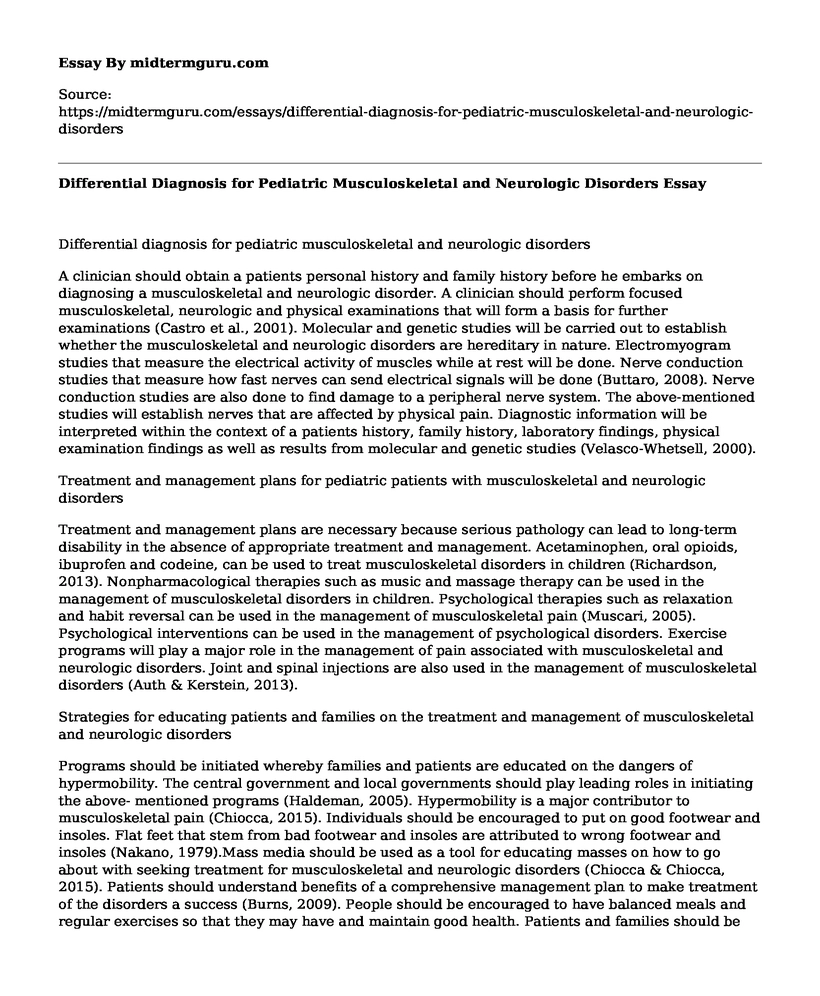Differential diagnosis for pediatric musculoskeletal and neurologic disorders
A clinician should obtain a patients personal history and family history before he embarks on diagnosing a musculoskeletal and neurologic disorder. A clinician should perform focused musculoskeletal, neurologic and physical examinations that will form a basis for further examinations (Castro et al., 2001). Molecular and genetic studies will be carried out to establish whether the musculoskeletal and neurologic disorders are hereditary in nature. Electromyogram studies that measure the electrical activity of muscles while at rest will be done. Nerve conduction studies that measure how fast nerves can send electrical signals will be done (Buttaro, 2008). Nerve conduction studies are also done to find damage to a peripheral nerve system. The above-mentioned studies will establish nerves that are affected by physical pain. Diagnostic information will be interpreted within the context of a patients history, family history, laboratory findings, physical examination findings as well as results from molecular and genetic studies (Velasco-Whetsell, 2000).
Treatment and management plans for pediatric patients with musculoskeletal and neurologic disorders
Treatment and management plans are necessary because serious pathology can lead to long-term disability in the absence of appropriate treatment and management. Acetaminophen, oral opioids, ibuprofen and codeine, can be used to treat musculoskeletal disorders in children (Richardson, 2013). Nonpharmacological therapies such as music and massage therapy can be used in the management of musculoskeletal disorders in children. Psychological therapies such as relaxation and habit reversal can be used in the management of musculoskeletal pain (Muscari, 2005). Psychological interventions can be used in the management of psychological disorders. Exercise programs will play a major role in the management of pain associated with musculoskeletal and neurologic disorders. Joint and spinal injections are also used in the management of musculoskeletal disorders (Auth & Kerstein, 2013).
Strategies for educating patients and families on the treatment and management of musculoskeletal and neurologic disorders
Programs should be initiated whereby families and patients are educated on the dangers of hypermobility. The central government and local governments should play leading roles in initiating the above- mentioned programs (Haldeman, 2005). Hypermobility is a major contributor to musculoskeletal pain (Chiocca, 2015). Individuals should be encouraged to put on good footwear and insoles. Flat feet that stem from bad footwear and insoles are attributed to wrong footwear and insoles (Nakano, 1979).Mass media should be used as a tool for educating masses on how to go about with seeking treatment for musculoskeletal and neurologic disorders (Chiocca & Chiocca, 2015). Patients should understand benefits of a comprehensive management plan to make treatment of the disorders a success (Burns, 2009). People should be encouraged to have balanced meals and regular exercises so that they may have and maintain good health. Patients and families should be urged to avoid bad postures as well as stressful positions that are likely to make them susceptible to the above-mentioned disorders (Lee, 2016)
Impact of culture on the treatment and management of musculoskeletal and neurologic disorders
Studies have revealed that ethnic variations have an impact on treatment and management of musculoskeletal and neurologic disorders. There are stereotypes associated with pain as it relates to individuals from different ethnicities. Ethnic minorities are associated with having a high pain tolerance when compared with Caucasians. As a result, most ethnic minorities who have musculoskeletal and neurologic disorders are often given mild, less potent forms of medications when compared with Caucasians (Harding et al., 2013). Studies have revealed that ethnic minorities are more likely to be undertreated for back pain when compared with Caucasians. The disparities in pain treatment among individuals from different races and ethnicities are based on stereotyped perceptions of individuals socio-economic status, language barriers, and ethnicity (Ricci, 2009).
References
Auth, P. C., & Kerstein, M. D. (2013). Physician assistant review. Philadelphia: Wolters Kluwer Health/Lippincott Williams & Wilkins.
Castro, W. H. M., Jerosch, J., & Grossman, T. W. (2001). Examination and diagnosis of musculoskeletal disorders: Clinical examination, imaging modalities. Stuttgart: Thieme.
Buttaro, T. M. (2008). Primary care: A collaborative practice. St. Louis, Mo: Mosby/Elsevier.
Burns, C. E. (2009). Pediatric primary care. St. Louis, Mo: Saunders/Elsevier.
Chiocca, E. M. (2015). Advanced pediatric assessment. New York, NY : Springer Publishing Company.
Chiocca, E. M., & Chiocca, E. M. (2015). Study Guide to Accompany Advanced Pediatric Assessment: A Case Study and Critical Thinking Review. New York: Springer Publishing Company.
Haldeman, S. (2005). Principles and practice of chiropractic. New York: McGraw-Hill, Medical Pub. Division.
Harding, M., Snyder, J. S., Preusser, B. A., & Winningham, M. L. (2013). Winningham's critical thinking cases in nursing: Medical-surgical, pediatric, maternity, and psychiatric. St. Louis, Mo: Elsevier/Mosby.
Lee, S. W. M. D. (2016). Musculoskeletal Injuries and Conditions: Assessment and Management. New York: Springer Publishing Company.
Muscari, M. E. (2005). Pediatric nursing. Philadelphia: Lippincott Williams & Wilkins.
Nakano, K. K. (1979). Neurology of musculoskeletal and rheumatic disorders. Boston: Houghton Mifflin Professional Publishers, Medical Division.
Ricci, S. S., & Kyle, T. (2009). Maternity and pediatric nursing. Philadelphia: Wolters Kluwer Health/Lippincott Williams & Wilkins.
Richardson, B. (2013). Pediatric primary care: Practice guidelines for nurses. Sudbury, Mass: Jones & Bartlett Learning.
Velasco-Whetsell, M. (2000). Pediatric nursing. New York: McGraw-Hill, Health Professions Division.
Cite this page
Differential Diagnosis for Pediatric Musculoskeletal and Neurologic Disorders. (2021, May 28). Retrieved from https://midtermguru.com/essays/differential-diagnosis-for-pediatric-musculoskeletal-and-neurologic-disorders
If you are the original author of this essay and no longer wish to have it published on the midtermguru.com website, please click below to request its removal:
- The Health Strategy is the Community Action Program for Public Health
- Legally, What is Quality Care? Understanding Nursing Standards - Article Review Paper Example
- Paper Example on Vaccination
- Peer Analysis of a Manuscript on Nature Journal
- PICC Lines: A Safe, Dependable Option for Patient Care - Essay Sample
- Family Health Care Nursing: A Comprehensive Overview - Essay Sample
- Social Work: Improving Living Standards and Empowering the Vulnerable - Essay Sample







